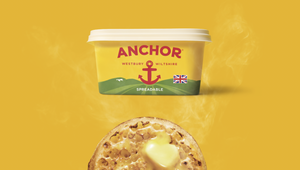In the current advertising landscape, humour has found its way back into the spotlight after years dominated by emotional, tear-jerking campaigns.
For Amy Fasey, associate creative director at Havas London, this return to light-heartedness is not only refreshing but necessary.
Amy speaks with LBB’s Olivia Atkins and delves into why brands should embrace humour, how it can build stronger connections with audiences, and why even in tough times, a good laugh might be just what the world needs.
Rekorder director Nash Edgerton recently shared this sentiment with LBB: "I like it when brands have a sense of humour and aren’t afraid to make fun of themselves." As the next article in Rekorder's ongoing series, Amy considers this quote ahead of our conversation.
From self-deprecating humour to poking fun at category clichés, Amy shares her insights into what makes comedic ads memorable and successful.
LBB> How do you perceive the current advertising landscape, and what role do you think humour plays in it?
Amy> For a while, it disappeared off the scene to make way for the tearjerkers. But comedy is the comeback kid. I, for one, am grateful. When I think of all the ads I loved in school, they were ones that made me spit out my Coco pops at breakfast. Jaffa Cakes’ ‘Full Moon’. Tango’s ‘Orangeman'. I don’t think we’re back to that sort of humour golden age yet, but the tide is turning.
LBB> In your opinion, what conditions are most conducive to successfully launching humorous ads? Considering the extreme polarisation of political views and ongoing global economic challenges, do you think humour is currently appropriate for brands to use?
Amy> Laughter is escapism. And considering the state of the world right now, by God do we need it. Obviously, humour works any time (that’s the beauty of it), but if there’s any time to ramp it up, it’s now. More funny please.
LBB> Havas has recently created some notable comedic ads, like Jayde Adams' Lemonade underwear ad and Asda’s latest ad with Joe Wicks. When crafting a comedy ad, what key factors do you consider to make it land correctly?
Amy> Our 'Lemonade Dolls' film (below) parodied the ad world, poking fun at the lingerie category. Lifting the lid on that cliché and letting the audience in on the joke definitely helped it land. And our ASDA spot with Joe Wicks also saw him poking fun at himself, having a gang of kids mimic him with a beard, barnet and all. I think they’re both types of self-deprecating comedy that audiences can easily get on board with.
LBB> Humour doesn’t work for every brand – what advice would you give agencies looking to engage audiences through comedy?
Amy> I mean, if you’re talking about funeral services or pile cream, maybe not. But then again, why not? Lightness around heavier (or grosser) subjects makes it easier to swallow (and buy your product). Evidence literally shows, more funny equals more money.
LBB> Why do you think comedy is such a powerful medium, particularly in advertising?
Amy> It’s accessible for almost everyone when done right.
LBB> How much do you think brands should be willing to poke fun at themselves? As a creative, how do you navigate conversations with clients to build their trust and encourage them to embrace humour?
Amy> Brits wouldn’t be Brits if they weren’t self-deprecating. Why not have the brands we love in the UK act the same way? Because clients should also be able to poke fun at themselves. And it’s these types of brands, who are already bravely forging forward in the comedy space, that set an example of how well it can work.
LBB> Ads that take risks tend to be memorable – how do you assess whether using comedy is a risk worth taking?
Amy> A recent one that comes to mind is the Curry’s gen z slang TikTok that’s gone viral. It could’ve easily gone down as cringe, but it was executed in juuust the right way. Perhaps if brands are more hesitant, social’s a good place to test the waters with what kind of humour goes down well, before moving onto other platforms.
LBB> Comedy doesn’t always translate well across cultures—what nuances should creatives be mindful of when developing humorous content for international audiences?
Amy> Surely, viral videos are an example of how well gags can translate across waters, cultures, and age groups. It’s about finding something that enough people can see a bit of themselves in, regardless of what language you speak.
LBB> Havas plans to invest €400 million into AI over the next four years. Do you think technology and automation could ever replicate human humour, and if so, should we be concerned?
Amy> As tech and AI continue to be used in our industry, they will inevitably become more intertwined with creativity. But, they’ll never know that feeling of wanting the ground to swallow you up when saying ‘you too’ or ‘enjoy your meal’ to a waitress. It’s often by leaning into those awkward human moments that make good comedy good. I’ll eat my hat when a robot cracks a good joke.

















